Meet the puggle: A high-energy, affectionate small mixed breed that’s a combination of the pug and beagle. Though short in stature, he’s the ideal pup for active families.

Puggle Overview
| OFFICIAL NAME | Puggle |
| COMMON NAME | Puggle |
| PET HEIGHT | 10 to 15 inches |
| PET WEIGHT | 14 to 30 pounds |
| LIFESPAN | 10 to 15 years |
| GOOD WITH | children, dogs, families |
| TEMPERAMENT | friendly, outgoing, playful, willful |
| INTELLIGENCE | medium |
| SHEDDING AMOUNT | normal |
| EXERCISE NEEDS | medium |
| ENERGY LEVEL | active |
| VOCAL LEVEL | frequent |
| DROOL AMOUNT | low |
| BREED GROUP | hybrid |
| BREED SIZE | small (0-25 lbs.) |
| COAT LENGTH | short |
| COLORS | black, fawn, gold / yellow, red |
| PATTERNS | bicolor, sable |
| OTHER TRAITS | apartment-friendly, good hiking companion, requires lots of grooming, strong loyalty tendencies, tendency to chew |
The puggle skyrocketed to popularity in the 1980s for good reason: This mixed breed combines the petite frame and adorably squishy features of the pug with the energy and athleticism of the beagle. At 10–15 inches tall and weighing 14–30 pounds, they're also apartment-sized—but be forewarned, puggles are not lapdogs.
The puggle temperament is pretty high energy and go-go-go. They love to stretch their legs and play, and need numerous energy outlets to stay happy. Puggles make wonderful companions for active families and enjoy being around other dogs.
Appearance
As with all mixed-breed dogs, what you get with a puggle is a bit of a grab bag. You might have a puggle with a more smooshed, puggish nose or a puggle with a more beagle-y build. But in general, puggles tend to have a medium-short snout, tawny coloring, longer legs than a pug, and floppy, forward-folding ears. They have large, dark eyes that can often have the pug's globular prominence, and can also inherit the pug's underbite.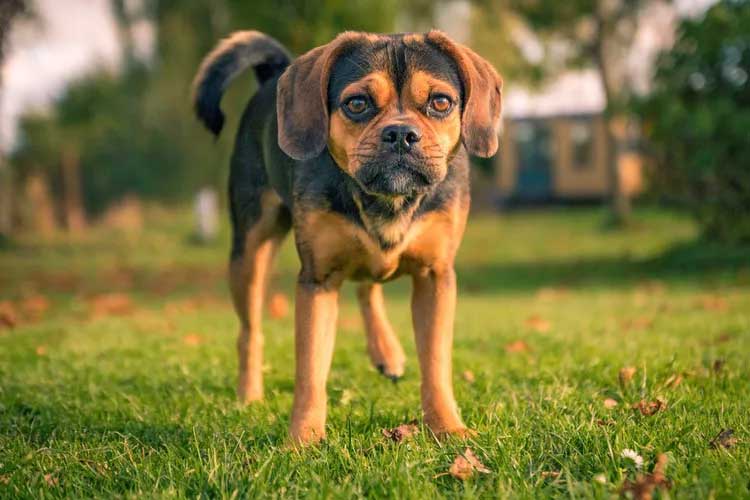
The puggle's coat is short, fine, and often soft and glossy like a pug's. A puggle will typically have fewer wrinkles than a pug, but maybe keep some folds around the face, giving them adorably exaggerated expressions. A note for those with allergies: This breed does shed, so he's not considered hypoallergenic. Puggle size will vary, but they fall within the range of 10–15 inches tall and weigh 14–30 pounds.
Temperament
There's a reason people who love pugs might opt for a puggle. Like their beagle forebears, puggles love to run and play, and they get along with other dogs well."They want a pug who is a little taller, a little more athletic and energetic—a lot of pugs tend to be sort of on the lower energy range," says Irith Bloom, a certified dog trainer and board member at the Certification Council for Professional Dog Trainers. "The addition of the beagle sort of gives you a more active dog."
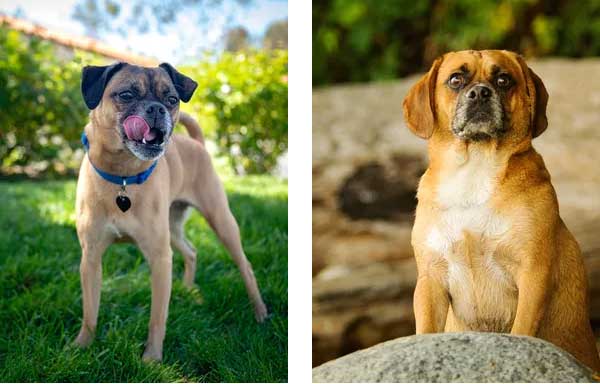
The puggle temperament is a sweet and fun-loving one. This pup tends to be very affectionate to his owners and greets new people with tail wags and face licks. He loves children, though it's important to teach children how to be gentle with dogs.
Puggles can be trained with patience and positivity, especially if you start when your puggle puppy is young. One trait Bloom has noticed in this mix is a kind of single-mindedness, in which they become obsessed with something and tune their humans out—a tendency that comes from their beagle side.
Living Needs
A puggle will be very happy in a home with a fenced-in yard he can run around in, though be ready for some digging and barking. They can also live in apartments with an owner who's dedicated to giving them regular, thorough exercise."You want to let them get out that fun energy in a way that's fun for both of you," Bloom says. "Otherwise, they will find ways that you don't think are fun."
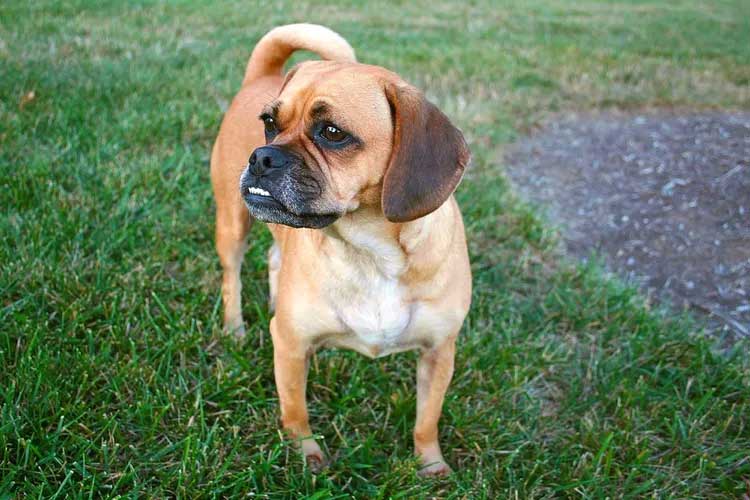
As with all dogs, if you don't let a puggle work out his energy and keep him mentally stimulated, they can develop undesirable behaviors. Bored dogs might go after your sofa or curtains, and you'll come home to find them in pieces throughout the house.
"What you'll often get is what I call 'a pogo dog,' where they jump up and down like a pogo stick because they're actually very athletic," Bloom says.
Because of their energy level, puggles make great exercise buddies. You can take them on walks, as well as moderate jogs and easy hikes (no mountainsides).
Puggles aren't very happy being left alone for long stretches of time, but they do love the company of other dogs—especially if their canine pal is ready for an exuberant BFF who loves to play.
Care
The puggle's coat is short, soft, and sheds seasonally with some regular shedding between seasons. Brush him weekly with a medium bristle brush or a rubber grooming mitt to remove loose hair, and give him a bath if he gets into something messy. If your puggle is particularly wrinkly, make sure to clean his wrinkles daily with pet wipes, baby wipes, or a damp cotton ball, and clean his ears, too.Your puggle needs plenty of exercise—some sources say at least an hour a day. Provide him with walks, jogs, hiking, games of tug-of-war or fetch, and playtime with other dogs at a dog park.
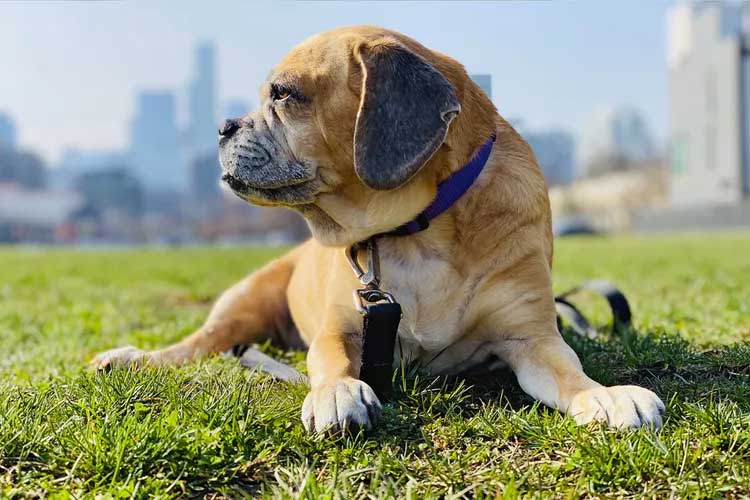
Depending on your pup's personality, training a puggle can require some work. Puggles can inherit a mischievous streak from their pug parent and can be a bit distracted because of their beagle side, so patient, positive reinforcement training is key—and treats help a lot!
"Any kind of training that uses treats as a reward is going to be really successful," Bloom says. "If they start to understand that when they do what you want, really good stuff happens for them, they will be much more willing to do what you want."
Health
One of the traits puggles are bred for is a longer snout than the brachycephalic (aka flat-faced) pug. "This means they breathe a little better," Bloom says. "They are less prone to, say, snoring and the sort of snorty snoring thing that you'll get out of any flat-faced breed."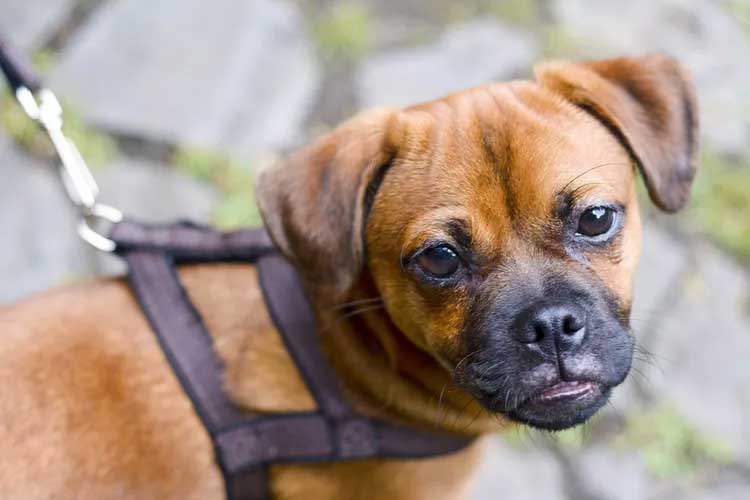
But this longer snoot isn't guaranteed: If you have a particularly flat-faced puggle, he can be prone to some of the same respiratory issues pugs can face, including difficulty breathing, wheezing, and noisy breathing. They can also be susceptible to heatstroke, so make sure your puggle has plenty of water, cool places to rest, and shade when he's outdoors in hot weather.
Both the beagle and the pug are prone to patellar luxation (or slip knee), hip dysplasia, and eye conditions. The best way to avoid these problems is to work with a breeder who screens both parents for health conditions before breeding them.
This mixed breed can be prone to overeating, so be sure to watch your puggle's weight and give him plenty of exercise so he doesn't become obese.
History
While there's no official record of when the first offspring between a pug and a beagle came into this world, we do know the puggle became popular in the U.S. in the '80s. The New York Times suggests that during this time people sought out smaller dogs for their smaller, urban homes, and many of those would-be dog owners wanted small pups that weren't frilly lap dogs.Enter the puggle. This athletic little pup has an illustrious background. Pugs were developed over thousands of years as cherished companions at the Chinese Imperial Court, and outsiders could only receive one as a gift. Later, they became the mascot for the Dutch royal court and became popular in England when William and Mary of Orange, proud pug owners, assumed the British throne.
Beagles, on the other hand, were bred in England as hunting dogs—unlike other hounds developed for the nobility, beagles could hunt on foot, meaning that common folks who didn't have horses could use the dogs. Beagles were imported to the U.S. after the Civil War, where they were immensely popular for rabbit hunting.
Thanks to both of these unique backgrounds, the puggle has both an aristocratic and a working dog heritage.
Fun Facts
Puggles became hugely popular around 2005, partly because of a growing demand for small dogs that weren’t fluffy arm candy, and partly because several high-profile celebrities adopted puggles, including Jake Gyllenhaal, Uma Thurman, James Gandolfini, and Julianne Moore.It’s pretty undeniable how cute the puggle can be, and there are plenty of Insta-puggles to keep track of. Meet Earl the Grump, a highly meme-able puggle with an adorably furrowed brow. Bentley is a puggle with a charming underbite and a French bulldog little bro. Riley is a sweet-faced puggle with huge, soft brown eyes and a puggle squad.